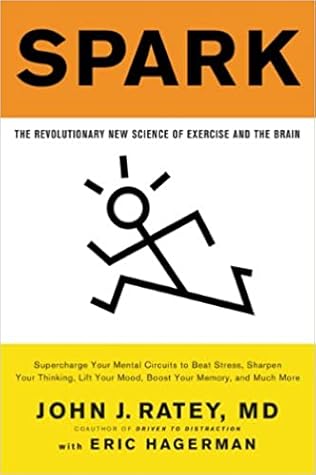More on this book
Community
Kindle Notes & Highlights
Read between
September 18 - October 1, 2017
It turns out that moving our muscles produces proteins that travel through the bloodstream and into the brain, where they play pivotal roles in the mechanisms of our highest thought processes.
“In our department, we create the brain cells,” Zientarski says. “It’s up to the other teachers to fill them.”
Darwin taught us that learning is the survival mechanism we use to adapt to constantly changing environments.
Serotonin, which you’ll hear a lot more about in later chapters, is often called the policeman of the brain because it helps keep brain activity under control. It influences mood, impulsivity, anger, and aggressiveness.
BDNF directs traffic and engineers the roads as well. Overall, it improves the function of neurons, encourages their growth, and strengthens and protects them against the natural process of cell death. And—as I hope to make clear throughout this book—BDNF is a crucial biological link between thought, emotions, and movement.
Exercise spawns neurons, and the stimulation of environmental enrichment helps those cells survive.
Now you know how exercise improves learning on three levels: first, it optimizes your mind-set to improve alertness, attention, and motivation; second, it prepares and encourages nerve cells to bind to one another, which is the cellular basis for logging in new information; and third, it spurs the development of new nerve cells from stem cells in the hippocampus.
Just as the mind can affect the body, the body can affect the mind.
The overarching principle of the fight-or-flight response is marshaling resources for immediate needs in lieu of building for the future—act
Two neurotransmitters put the brain on alert: norepinephrine arouses attention, then dopamine sharpens and focuses it. An imbalance of these neurotransmitters is why some people with attention-deficit/hyperactivity disorder (ADHD) come across as stress junkies. They have to get stressed to focus. It’s one of the primary factors in procrastination.
A need for stress also explains why ADHD patients sometimes seem to shoot themselves in the foot. When everything is going well, they need to stir up the situation, and they subconsciously find a way to create a crisis.
Operating on a fixed budget of fuel, the brain has evolved to shift energy resources as necessary, meaning that mental processing is competitive. It’s simply not possible to have all of our neurons firing at once, so if one structure is active, it must come at the expense of another. One of the problems with chronic stress is that if the HPA axis is guzzling all the fuel to keep the system on alert, the thinking parts of the brain are being robbed of energy.
Sporadic attention can be a real strength in a frenetic setting. People with shadows of ADHD might retain problems with organization, forgetfulness, and personal relationships, but they can get it together when the pressure is on.
In smokers, just five minutes of intense exercise can be beneficial. Nicotine is an oddball among addictive substances as it works as a stimulant and a relaxant at the same time. Exercise fights the urge to smoke because in addition to smoothly increasing dopamine it also lowers anxiety, tension, and stress levels—the physical irritability that makes people so grouchy when they’re trying to quit. Exercise can fend off cravings for fifty minutes and double or triple the interval to the next cigarette. And the fact that exercise sharpens thinking comes into play here, because one of the
...more
The mental and physical diseases we face in old age are tied together through the cardiovascular system and metabolic system. A failure of these underlying connections explains why people who are obese are twice as likely to suffer from dementia, and why those with heart disease are at far greater risk of developing Alzheimer’s, the most common form of dementia. Statistically, having diabetes gives you a 65 percent higher risk of developing dementia, and high cholesterol increases the risk 43 percent. We’ve had the medical proof that exercise protects against these diseases for decades, yet,
...more


